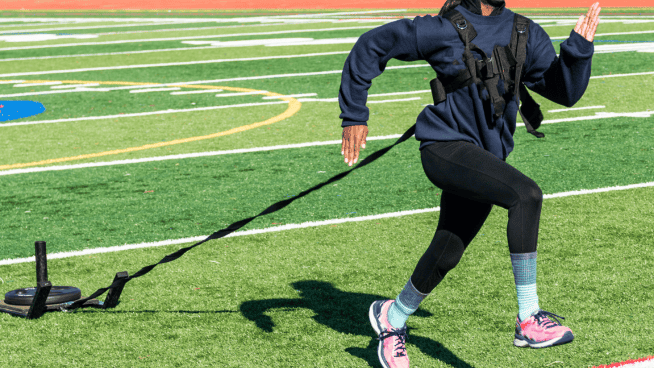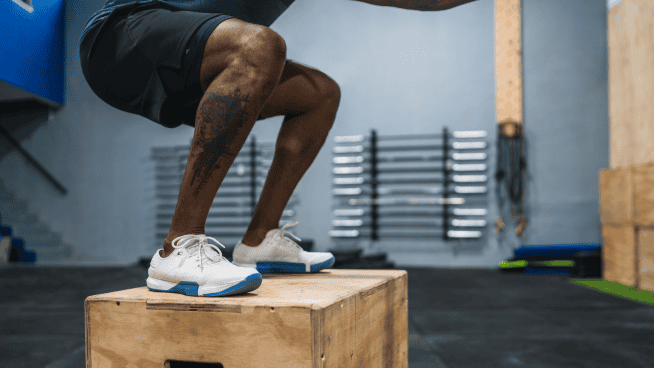3 Exercises That Can Help You Squat Without Knee Pain
“Squats are the devil.”
“They hurt my knees.”
“I can’t do Lunges or Squats.”
“My knees can’t take squats or jumping.”
These phrases have become incredibly common to strength coaches and fitness professionals. The exercise’s reputation has gotten notoriously worse over the years, and I hear it on a weekly basis from the new members and athletes who come into Over-Achieve Fitness.
They take a look at a workout and immediately cringe at the sight of any knee-dominant exercises. But who’s to say that the movement itself is truly the culprit behind your knee pain?
Quite often, I believe there are other things to blame. One is bad form. Another is that areas of your body are comparatively weak. It’s not that Squats are the devil—it’s that you either don’t know to perform them correctly or are performing variations too advanced for your current training level.
Let’s break down some of the biggest reasons Squats can lead to knee pain.
One is that you’re simply not setting yourself up properly. Most often, this means that your ankles, hips and shoulders are not properly aligned. There are a lot of ways to botch the set-up for a squat. You may be allowing your feet to overpronate, causing your knees to collapse inwards. You may be allowing your shoulders to come too far forward over your knees, creating unnecessary stress. There’s no one right way to set up for a Squat, but a shoddy setup will doom you from the start. This guide offers an outline on How to Do Back Squats the Right Way.
Then there’s the very real chance you’re not activating the correct prime movers and synergists in your Squats and squat-centric exercises. If your glutes aren’t functioning properly, that’s going to an issue. Being weak in the posterior chain can wreak havoc on your posture and make the front of your body overwork to compensate, leading to larger amounts of knee stress. Here’s how to tell if your glutes might be “dead,” and how you can go about reviving them.
You could also have weak ankles and/or limited range of motion, which, like weak and inactive glutes, is much more common than you might believe. Poor ankle mobility can cause a ripple of issues all throughout the body. Know what the next joint above the ankle is? That’s right, the knee. This simple test can help you see if your ankle mobility might be causing issues.
Worrying about having to “squat low” can be another problem. Perhaps this is something plaguing your own mind, or it’s something you’re being told by a misguided trainer or friend. This is something many fitness professionals get wrong during programming in that they believe a “good Squat” is one that reaches parallel. Different body types and structures as well as mobility of each individual will affect their depth. A good Squat is never one that causes pain.
Don’t continue squatting if you find it’s bringing you pain. Take a step back, analyze your situation, and try to assess some underlying causes of that pain. Because the movement pattern of the Squat itself, in the abstract, is not the issue.
More often than not, you can get a large amount of relief by first releasing tight areas surrounding/supporting your knees and then strengthening your glutes and hamstrings or improving mobility of your hips and ankles. Common contributors to knee pain can be related to IT band syndrome, weak or tight quads, or weak glutes.
The last thing you should do is abandon posterior chain training all together. With that in mind, below are some great exercises you can try as you work your way toward pain-free squatting. These moves target many of the problem areas that could be hampering your squat pattern.
1. RFE Kettlebell Band-Resisted Hinge
This exercise is a killer combo for building quad strength while firing the hamstrings. Attach the band right above the knee while elevating your back leg onto a bench. The key point is to focus on keeping a strong posture and hinging your hips back as you would if you were performing a Romanian Deadlift. The band acts as a counter to stabilize and strengthen the knee. A good way to program this would be as a primer for 3-4 sets of 6-8 reps per leg.
2. Sliding Body Curls
These are one of my favorite exercises because they really work the hamstrings and are very easy on the low back and knees. They are a knee-flexion based exercise where the glutes must stay engaged, making them similar to Glute Ham Raises, but these are easily done with minimal equipment. You cannot see it here, but I’ve got three sliders placed underneath the plate that’s below my torso. 3-4 sets of 6-8 reps will work great for this!
3. Slider Leg Curls
These are an easier variation of the Sliding Body Curl. The goal is to maintain a strong glute contraction throughout the exercise and to “hold the bridge,” as I like to cue my clients. They can be great for primer work or as a supplemental exercise to a posterior chain-focused session. Shoot for 3-4 sets of 6-8 reps.
Don’t let knee pain be an excuse for missing workouts and avoiding activity. Just be mindful of why they’re actually bothering you, decide what you are able to achieve without pain, and make a plan to help avoid pain in the future! You can learn more about knee pain and how to correct it in my total knee recovery guide.
Photo Credit: LightFieldStudios/iStock
READ MORE:
RECOMMENDED FOR YOU
MOST POPULAR
3 Exercises That Can Help You Squat Without Knee Pain
“Squats are the devil.”
“They hurt my knees.”
“I can’t do Lunges or Squats.”
“My knees can’t take squats or jumping.”
These phrases have become incredibly common to strength coaches and fitness professionals. The exercise’s reputation has gotten notoriously worse over the years, and I hear it on a weekly basis from the new members and athletes who come into Over-Achieve Fitness.
They take a look at a workout and immediately cringe at the sight of any knee-dominant exercises. But who’s to say that the movement itself is truly the culprit behind your knee pain?
Quite often, I believe there are other things to blame. One is bad form. Another is that areas of your body are comparatively weak. It’s not that Squats are the devil—it’s that you either don’t know to perform them correctly or are performing variations too advanced for your current training level.
Let’s break down some of the biggest reasons Squats can lead to knee pain.
One is that you’re simply not setting yourself up properly. Most often, this means that your ankles, hips and shoulders are not properly aligned. There are a lot of ways to botch the set-up for a squat. You may be allowing your feet to overpronate, causing your knees to collapse inwards. You may be allowing your shoulders to come too far forward over your knees, creating unnecessary stress. There’s no one right way to set up for a Squat, but a shoddy setup will doom you from the start. This guide offers an outline on How to Do Back Squats the Right Way.
Then there’s the very real chance you’re not activating the correct prime movers and synergists in your Squats and squat-centric exercises. If your glutes aren’t functioning properly, that’s going to an issue. Being weak in the posterior chain can wreak havoc on your posture and make the front of your body overwork to compensate, leading to larger amounts of knee stress. Here’s how to tell if your glutes might be “dead,” and how you can go about reviving them.
You could also have weak ankles and/or limited range of motion, which, like weak and inactive glutes, is much more common than you might believe. Poor ankle mobility can cause a ripple of issues all throughout the body. Know what the next joint above the ankle is? That’s right, the knee. This simple test can help you see if your ankle mobility might be causing issues.
Worrying about having to “squat low” can be another problem. Perhaps this is something plaguing your own mind, or it’s something you’re being told by a misguided trainer or friend. This is something many fitness professionals get wrong during programming in that they believe a “good Squat” is one that reaches parallel. Different body types and structures as well as mobility of each individual will affect their depth. A good Squat is never one that causes pain.
Don’t continue squatting if you find it’s bringing you pain. Take a step back, analyze your situation, and try to assess some underlying causes of that pain. Because the movement pattern of the Squat itself, in the abstract, is not the issue.
More often than not, you can get a large amount of relief by first releasing tight areas surrounding/supporting your knees and then strengthening your glutes and hamstrings or improving mobility of your hips and ankles. Common contributors to knee pain can be related to IT band syndrome, weak or tight quads, or weak glutes.
The last thing you should do is abandon posterior chain training all together. With that in mind, below are some great exercises you can try as you work your way toward pain-free squatting. These moves target many of the problem areas that could be hampering your squat pattern.
1. RFE Kettlebell Band-Resisted Hinge
This exercise is a killer combo for building quad strength while firing the hamstrings. Attach the band right above the knee while elevating your back leg onto a bench. The key point is to focus on keeping a strong posture and hinging your hips back as you would if you were performing a Romanian Deadlift. The band acts as a counter to stabilize and strengthen the knee. A good way to program this would be as a primer for 3-4 sets of 6-8 reps per leg.
2. Sliding Body Curls
These are one of my favorite exercises because they really work the hamstrings and are very easy on the low back and knees. They are a knee-flexion based exercise where the glutes must stay engaged, making them similar to Glute Ham Raises, but these are easily done with minimal equipment. You cannot see it here, but I’ve got three sliders placed underneath the plate that’s below my torso. 3-4 sets of 6-8 reps will work great for this!
3. Slider Leg Curls
These are an easier variation of the Sliding Body Curl. The goal is to maintain a strong glute contraction throughout the exercise and to “hold the bridge,” as I like to cue my clients. They can be great for primer work or as a supplemental exercise to a posterior chain-focused session. Shoot for 3-4 sets of 6-8 reps.
Don’t let knee pain be an excuse for missing workouts and avoiding activity. Just be mindful of why they’re actually bothering you, decide what you are able to achieve without pain, and make a plan to help avoid pain in the future! You can learn more about knee pain and how to correct it in my total knee recovery guide.
Photo Credit: LightFieldStudios/iStock
READ MORE:










